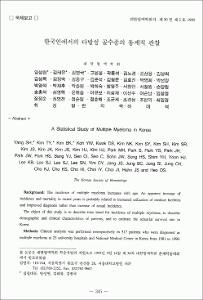KUMEL Repository
1. Journal Papers (연구논문)
1. School of Medicine (의과대학)
Dept. of Internal Medicine (내과학)
한국인에서의 다발성 골수종의 통계적 관찰
- Affiliated Author(s)
- 송홍석
- Alternative Author(s)
- Song, Hong Suk
- Journal Title
- 대한혈액학회지
- ISSN
- 1225-0546
- Issued Date
- 1995
- Abstract
- Background: The incidence of multiple myeloma increases with age. An apparant
increase of incidence and mortality in recent years is probably related to increased
utilization of medical facilities and improved diagnosis rather than increase of actual
incidence.
The object of this study is to describe time trend for incidence of multiple myeloma,
to describe demographic and clinical characteristics of patients, and to estimate the
actuarial survival rate in Korea.
Methods: Clinical analysis was performed retrospectively in 517 patients who were
diagrnosed as multiple myeloma at 23 university hospitals and National Medical Center
in Korea from 1981 to 1990.
Results : 1) Annual incidence appears to be increasing. Crude annual incidence rate between
1989 and 1990 was 0.2 per 100,000 population.
2) The median age at diagnosis was 58 years of age and 58% of patients were under
age 60. Male to female ratio was 1.5 : 1.
3) Initial findings were bone pain in 42%, GI symptoms in 10.3%, anemia in 7.4%,
bleeding in 7.4%, and renal insufficiency in 7.4%.
4) The clinical stage at presentation were stage I in 13%, stage Ⅱ in 21%, and stage
Ⅲ in 66%. Patients with B stage were 33%.
5) Hematological evaluation revealed anemia in 87%, leukopenia in 19%,
thrombocytopenia in 17%, and Rouleau formation in 60%. Bone amrrow plasmacytosis
more than 30% were seen in 68%.
6) Blood chemistries showed hyperproteinemia in 54%, hypercalcemia in 24%, and
azotemia in 47%. β₂-microglobulin level was elevated in 69%.
7) Serum immunoelectrophoresis reveated M-protein as IgG in 63%, as IgA in 20%,
as IgD in 4%, and light chain only in 12%. The ratio of kappa to lambda was 1.19 : 1.
8) Skeletal roentgenographic abnormalities were seen in 81%.
9) Melphalan and combination chemotherapy were used in 86% of the patients.
Response rate was 53%. Follow-up information was obtained in 37% of 517 patients.
Among 193 followed-up patients, 140(73%) have died. Infection and renal insufficiency
were the most common specific cause of death. The median survival was 3. 4 years.
Conclusion : Incidence rate for multiple myeloma in Korean was quite lower and age at
diagnosis was younger than that of whites and blacks. So it is necessary to make more
accurate tumor registry data to clarify the lower incidence and etiologic implication.
Further well-controlled clinical trial using aggressive treatment strategies should be
evaluated in such a younger patients in Korea.
- Alternative Title
- A Statistical Study of Multiple Myeloma in Korea
- Department
- Dept. of Internal Medicine (내과학)
- Publisher
- School of Medicine
- Citation
- 양성현 et al. (1995). 한국인에서의 다발성 골수종의 통계적 관찰. 대한혈액학회지, 30(3), 345–361.
- Type
- Article
- ISSN
- 1225-0546
- Appears in Collections:
- 1. School of Medicine (의과대학) > Dept. of Internal Medicine (내과학)
- 파일 목록
-
-
Download
 oak-bbb-4191.pdf
기타 데이터 / 4.01 MB / Adobe PDF
oak-bbb-4191.pdf
기타 데이터 / 4.01 MB / Adobe PDF
-
Items in Repository are protected by copyright, with all rights reserved, unless otherwise indicated.